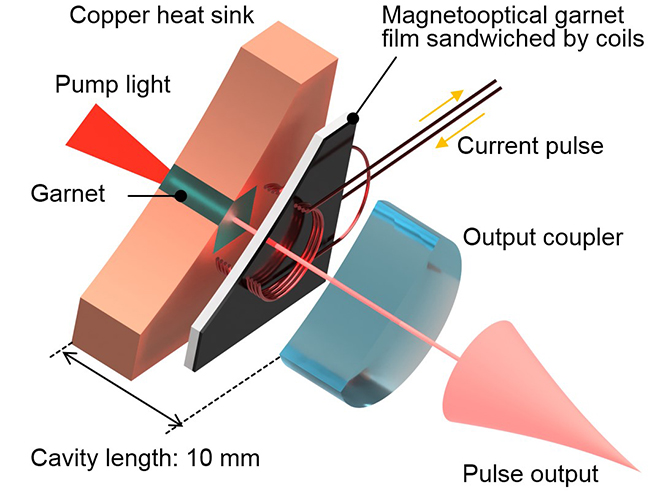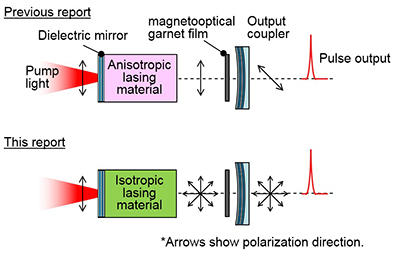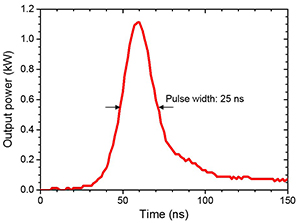
ここからコンテンツです。

New Smaller Laser Achieved One-Digit Higher Output
By using randomly polarized laser beam with a "Q switch" By Taichi Goto
Taichi Goto at Toyohashi University of Technology and his international research team have produced the first high-powered, randomly polarised laser beam with a “Q switch” laser, which typically emits pulses of light so brief that they’re measured in Kilowatts per nanosecond. Lasers are a critical part of modern technology—they’re used in everything from our automobiles to medical equipment to the satellites orbiting Earth. Now, researchers are broadening the potential applications of even smaller and more powerful lasers.
“The experimental evidence provided in this study advances this research field toward the realization of actively controllable integrated micro lasers,” said Taichi Goto, second author of the paper and an assistant professor in the Department of Electrical and Electronic Information Engineering at Toyohashi University of Technology.

Other study contributors include scientists from the Institute for Molecular Science at the Laser Research Centre in Japan and the Electrical and Computer Engineering Department at Iowa State University in the United States.
Q switch lasers are used in a variety of applications, including in surgical procedures, and can produce more precise results with less damage than traditional tools. The lasers require integration of active and passive responsibilities for maximum efficiency.
"There are two advantages to actively controlling integrated micro lasers," said Goto. “Firstly the small size of the lasers allows for the use of mass production techniques. Secondly, the price of each Q switch laser can be lowered thanks to the integration.”
A technique called Q switching produces short but high-powered pulse outputs. As in other lasers, an electric current excites electrons in a laser medium − in this case, it’s a crystal used in solid-state lasers − and emits the resulting energy as amplified light. The light can be polarized in one direction or another, but it’s nearly impossible to change the randomly polarized light in a small Q switch laser.
Goto and his team used Q switching, along with a laser a tenth of the size of one cent, to produce a laser beam ten times more powerful than previously reported with larger lasers.

Along with the change of laser size, the researchers also adjusted the magnetic material through which the light travels and amplifies to a more powerful pulse. With the addition of a neodymium-yttrium-aluminum-garnet, Goto could use magneto-optics to better control how the light moves within the laser cavity.
The short pulses allow the researchers to change the polarization of the laser through manipulation of the photons comprising the light. Instead of a constant light, each pulse can be switched. The laser size means the energy punches out, instead of dissipating as it travels inside the system.
The researchers plan to increase the peak power of their system, according to Goto. They also plan to apply the system as an integrated micro laser for further testing.
Reference
Ryohei Morimoto, Taichi Goto, Takunori Taira, John Pritchard, Mani Mina, Hiroyuki Takagi, Yuichi Nakamura, Pang Boey Lim, Hironaga Uchida and Mitsuteru Inoue, "Randomly polarised beam produced by magnetooptically Q-switched laser", Scientific Reports, 7, 15398 (2017).
https://doi.org/10.1038/s41598-017-15826-3
世界初!磁気を使って小型レーザーで1キロワット出力を達成
ランダム偏光に対する磁気を使ったQスイッチを用いてBy 後藤 太一
豊橋術科学大学、自然科学研究機構分子科学研究所、アイオワ州立大学の研究者らは、共同で磁場と光の相互作用である磁気光学効果を発現する膜を用いた、集積化可能なQスイッチレーザーのピークパワーを1キロワットまで高めました。さらに、従来不可能と考えられてきたランダム偏光(無偏光)の光に対しても磁気を使ったQスイッチが有効であることを示しました。集積可能であるため、大量生産により大幅に価格が下がることが期待できます。
高出力かつ小型で丈夫なレーザーは、自動車の衝突防止センサーや医療機器、機械加工、レーザー点火などで使われ、その活躍の場は現在急激に広がっています。
豊橋技術科学大学、自然科学研究機構分子科学研究所、アイオワ州立大学の研究者らのグループは、最近開発に成功した迷路状の磁気ドメインをもつ透明磁性材料を用いた薄膜Qスイッチレーザーの高出力化に成功しました。このレーザーのピークパワーは、1.1キロワットに達しました。これは、同手法を用いた従来報告されていたパワーよりも1桁大きな値です。
そのしくみについて、「レーザーを形作る共振器(キャビティー)を、他の制御可能なQスイッチ素子では達成が難しい10 mmまで縮めることで、パルス幅を短くしています。」と本論文の責任著者の後藤助教は、述べています。
同グループは、これまでも、磁気光学効果を使ったQスイッチレーザーを報告してきていますが、出力光の偏光状態は、直線偏光に限られていました。今回の研究で初めて、同構成のレーザーにより、ランダム偏光(無偏光)の光出力も得られることが明らかになり、これにより扱える光の状態が大幅に広がりました。
さらに今回の研究結果は、ガーネット構造をもつレーザー結晶と、同じくガーネット構造をもつ透明磁性膜の組合せで実証されました。これにより従来よりも、レーザー結晶と透明磁性膜の融合が遥かに容易になり、集積化の可能性を大きく高めました。今後、レーザー結晶とQスイッチ膜の一体化が進めば、素子1つあたりの価格が大幅に安くなることが期待されます。
本研究は、以下の助成を受けて行われました。
- 日本学術振興会 科研費 26220902, 17K19029, 17J05958
- 国立研究開発法人 科学技術振興機構 さきがけ JPMJPR1524
- 矢崎科学技術振興記念財団
Researcher Profile

| Name | Taichi Goto |
|---|---|
| Affiliation | Department of Electrical and Electronic Information Engineering |
| Title | Assistant Professor |
| Fields of Research | Magnetics / Optics/ Photonics/ Nanotechnology/ Spintronics/ Magnonics |
ここでコンテンツ終わりです。

